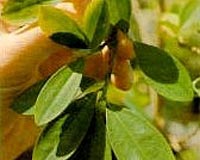 |
for The Hot Zone Moffett Field CA (SPX) Apr 26, 2011 Rapid increases in greenhouse gases have happened more frequently in the Earth's history than previously realized, according to a Scripps Institution of Oceanography-led study published in the journal Nature. Scientists have studied extensively the the Palaeocene-Eocene Thermal Maximum (PETM), about 56 million years ago, a period of rapid global warming that's associated with a temperature spike on par with expectations for today's global warming scenarios. But according to the Scripps Institute, there's been a series of six smaller greenhouse gas fluxes during the same geologic time period (the Palaeocene and Eocene epochs, 65 to 34 million years ago). These so-called "modest hyperthermals" (meaning a rapid, pronounced period of global warming) had shorter durations and recoveries (about a 40,000 year cycle) and involved an exchange of carbon between surface reservoirs into the atmosphere and then into sediment. The researchers believe that large-scale carbon releases were vented from the ocean floor, but were reburied relatively quickly. Under higher CO2 levels, plants take up more toxic materials Higher concentrations of CO2 in the atmosphere generally increase plant growth and productivity. Plants take up more nutrients from the soil. But according to a new study, they also take up more toxic materials from the soil. Benjamin Duval from the University of Illinois at Urbana-Champaign and colleagues showed in a paper published in the journal Environmental Science and Technology that contaminants in the soil become increasingly mobile in vegetation and that these toxins could be cycling faster through the ecosystem. "Plants can't always distinguish toxic elements from nutrients," Duval said in a review of his study published in Chemical and Engineering News. "For instance, arsenic can look a lot like phosphorous, which plants need for their metabolism." Duval and company collected soil and oak tree samples from a site at the Kennedy Space Center in Florida run by the Smithsonian Environmental Research Center. They measured toxins in samples growing under normal CO2 levels and compared them to those growing at 700 parts per million CO2, roughly double the concentration. They found that concentrations of the 13 metals studied, which included lead, cadmium, and arsenic, among others, were up to twice as high in the plant materials in the elevated CO2 samples. The researchers point out that the rates are worrisome because the toxic metals may be ingested up the food chain and can depress the decomposition rates of plant litter and hinder soil microbial activity. The implications for people eating food crops under such a scenario is also troubling. Although, according to Duval, the current uptake of heavy metals didn't exceed toxic thresholds set by health agencies.
Share This Article With Planet Earth
Related Links Scripps Institute Climate Science News - Modeling, Mitigation Adaptation
 Leaf Characteristics Improves Accuracy Measuring Past Climates
Leaf Characteristics Improves Accuracy Measuring Past ClimatesWashington DC (SPX) Apr 21, 2011 A study led by Baylor University and Wesleyan University geologists shows that a new method that uses different size and shape traits of leaves to reconstruct past climates over the last 120 million years is more accurate than other current methods. The study appeared in the April issue of the journal New Phytologist and was funded by the National Science Foundation. "Paleobotanists ... read more |
|
| The content herein, unless otherwise known to be public domain, are Copyright 1995-2010 - SpaceDaily. AFP and UPI Wire Stories are copyright Agence France-Presse and United Press International. ESA Portal Reports are copyright European Space Agency. All NASA sourced material is public domain. Additional copyrights may apply in whole or part to other bona fide parties. Advertising does not imply endorsement,agreement or approval of any opinions, statements or information provided by SpaceDaily on any Web page published or hosted by SpaceDaily. Privacy Statement |